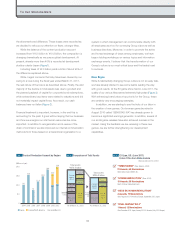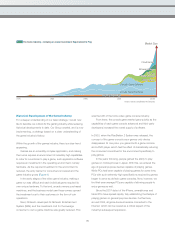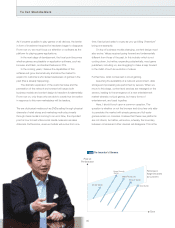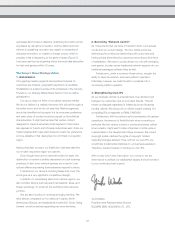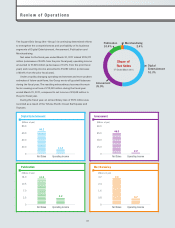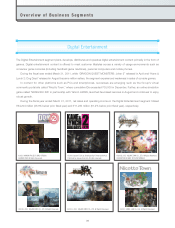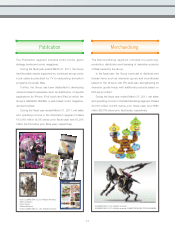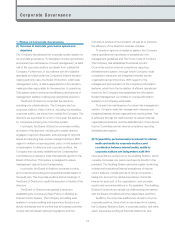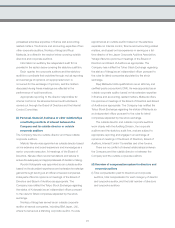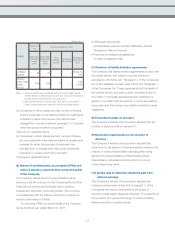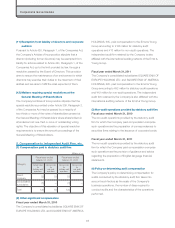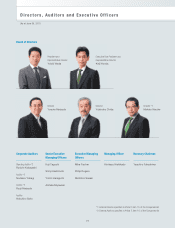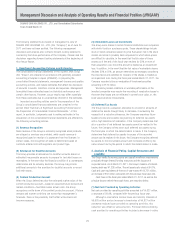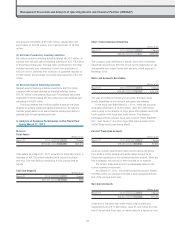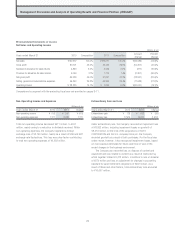Square Enix 2011 Annual Report Download - page 16
Download and view the complete annual report
Please find page 16 of the 2011 Square Enix annual report below. You can navigate through the pages in the report by either clicking on the pages listed below, or by using the keyword search tool below to find specific information within the annual report.
1. Status of Corporate Governance
(1) Overview of corporate governance system and
objectives
The Company has adopted the corporate auditor system for
its corporate governance. To strengthen monitoring functions
and ensure the maintenance of sound management, at least
half of the corporate auditors are drawn from outside the
Company. Furthermore, in accordance with the objective
standards provided under the Company’s internal decision-
making authority rules, the Board of Directors, which sets
management policy, is clearly separated from the decision-
making bodies responsible for the execution of operations.
This system aims to enhance the efficiency and balance of
management decision-making and operational execution.
The Board of Directors comprises five directors,
including one outside director. The Company has four
corporate auditors, three of whom, including one standing
corporate auditor, are drawn from outside the Company. The
directors are appointed for a term of one year, the same as
for companies adopting the committee system.
In principle, the Board of Directors convenes monthly,
and each of the directors, including the outside director,
engages in vigorous discussion and exchange of opinions
aimed at enhancing their mutual oversight functions. With
regard to matters concerning basic policy on the system of
compensation for directors and corporate auditors, the
Company has voluntarily established the Compensation
Committee as an advisory body that submits reports to the
Board of Directors. This system is designed to ensure
management objectivity and transparency.
In principle, the Board of Auditors convenes monthly,
and conducts accounting and operational audits based on
the audit plan. The corporate auditors attend meetings of
the Board of Directors to audit the execution of duties of the
directors.
The Board of Directors has passed a resolution
establishing the Company’s Basic Policy on Building an
Internal Control System. The Company is building such
systems to ensure auditing and supervisory functions are
strictly maintained and to confirm that all business activities
comply with all relevant laws and regulations and the
Company’s Articles of Incorporation, as well as to enhance
the efficiency of the directors’ exercise of duties.
To ensure a rigorous compliance system, the Company
clearly specifies the importance of compliance in its
management guidelines and The Group Code of Conduct.
The Company has established the Internal Control
Committee and an internal compliance reporting
(whistleblower) system, through which Company-wide
compliance measures are integrated laterally across
organizational reporting lines. With regard to the
management and operation of the Company’s information
systems, which form the foundation of efficient operational
functions, the Company has established the Information
System Management Committee to oversee information
systems on a Company-wide basis.
To ensure the maintenance of a robust risk management
system, Company-wide risk management measures are
integrated laterally across organizational reporting lines. This
is achieved through the reinforcement of relevant internal
organizational divisions, and the establishment of the Internal
Control Committee and an internal compliance reporting
(whistleblower) system.
(2) Organization, personnel and procedures for internal
audits and audits by corporate auditors; and
coordination between internal audits, audits by
corporate auditors and independent audit firm
Internal audits are carried out by the Auditing Division, which
currently comprises one person and reports directly to the
president. The Auditing Division performs regular monitoring,
reviews and evaluations (internal evaluations) of internal
control systems, including those of Group companies—
taking into account the relative importance of and risk
inherent in each part of the organization—and provides
reports and recommendations to the president. The Auditing
Division’s functions are carried out while sharing information
with the Board of Auditors and the independent audit firm.
Audits by the corporate auditors are carried out by four
corporate auditors, three of whom are drawn from outside
the Company. Nobuhiro Saito, a corporate auditor, has many
years’ experience working at financial institutions, and
Corporate Governance
14


